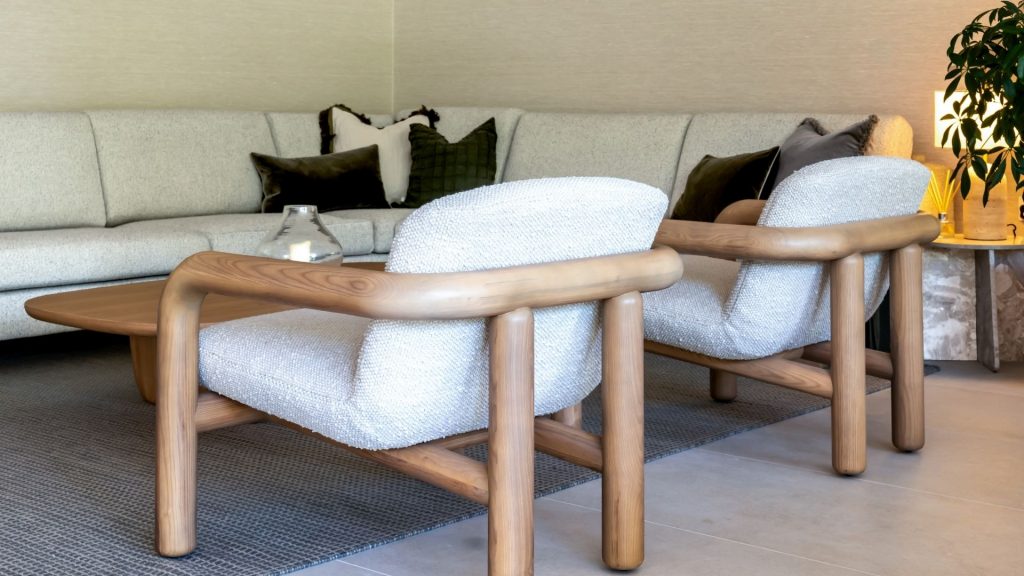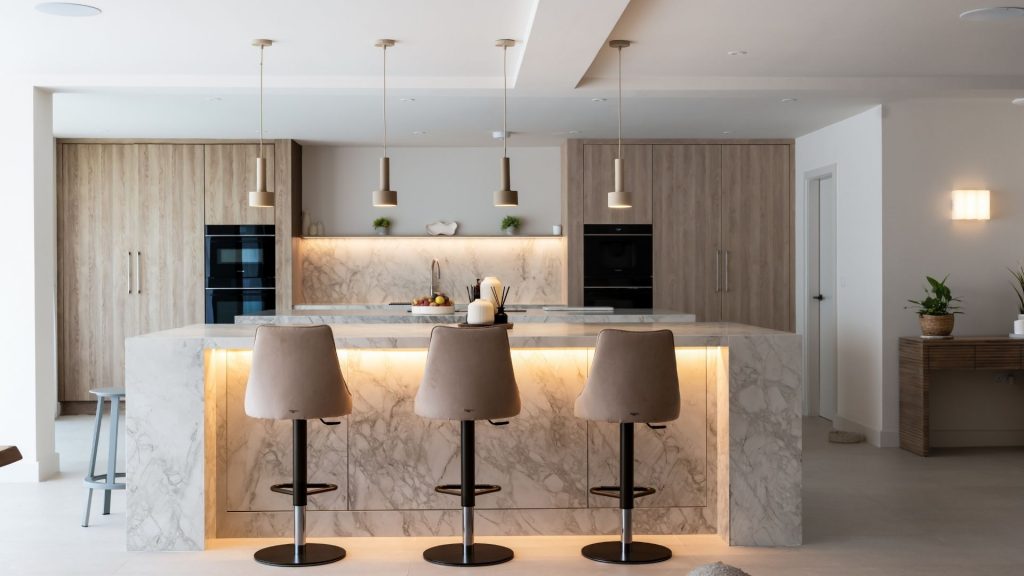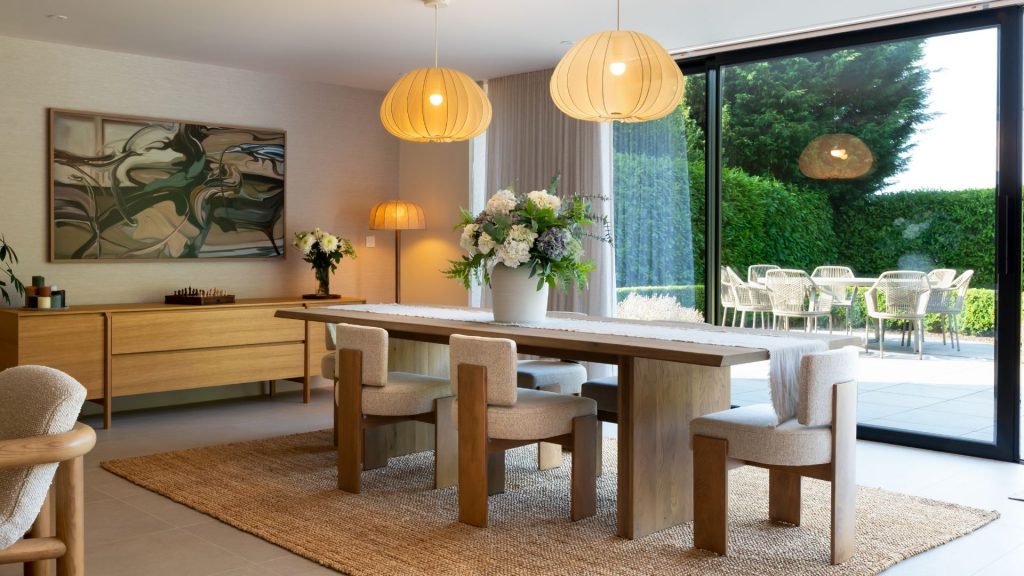Minimalist interiors often get a bad rep for feeling cold and clinical. When people think about this design style, they picture stark white rooms devoid of warmth or personality (like you’d find in a mausoleum).
But actually, true minimalism isn’t about stripping away comfort in favour of cleanliness – it’s about refining a space to feel intentional and effortless in its purpose. It’s also about developing a space where cleanliness is inviting, rather than a turn-off.
A well-designed minimalist interior balances simplicity with depth, creating a space that feels calming rather than empty.
The secret to designing a minimalist space is layering textures, selecting the right materials, and adding depth in all the right places, allowing it to feel warm, stylish, and lived-in rather than cold and sterile.
Here’s what you need to know to help you achieve a minimalist interior design style, without it feeling cold.

Texture is the secret to depth and warmth
Minimalist interiors don’t have to feel flat or one-dimensional. The key to avoiding that clinical feel is layering materials in a way that adds depth and interest.
A common mistake is assuming minimalism means keeping everything identical – matching colours, textures, and finishes throughout a space.
But too much uniformity makes a room feel lifeless.
The best minimalist spaces balance simplicity with contrast. Layering different textures and finishes prevents a room from feeling stark while keeping the aesthetic refined.
- • Soft vs. hard textures: A linen sofa against a polished stone coffee table balances warmth with structure.
- • Matte vs. glossy finishes: Natural wood alongside sleek metal or glass details creates dimension.
- • Rough vs. smooth surfaces: Woven fabrics against smooth plaster, or leather seats next to brushed brass fixtures introduce subtle contrast.
Texture isn’t just about fabrics – it’s in the details of the space itself.
Skirting boards, coving profiles, and bespoke joinery add depth, while lighting choices can soften hard edges and highlight different textures within a room.
The right colour palette is key to avoiding a sterile look
A common misconception is that minimalism means sticking to whites and greys. While neutral tones are a key feature of minimalist design, choosing the wrong shades can leave a space feeling lifeless.
The trick is understanding undertones. Instead of stark, cool-toned whites and greys, warm, earthy neutrals can be used to create a much cosier atmosphere. Soft beiges, warm greys, and off-whites with subtle yellow or red undertones bring warmth and depth, rather than feeling flat and sterile.
Colour isn’t just about the choice of paint. Warmth can also come from natural materials – think about a wooden headboard against an off-white wall in the bedroom, marbled stone with warm veining in a bathroom, or woven textiles in soft, organic hues adding depth to a neutral sofa.
These elements work together to bring life into a minimalist space while keeping the aesthetic refined.

Balancing form with function (minimalism without coldness)
A minimalist home isn’t just about how it looks – it’s about how it works. The key is to strip back unnecessary clutter without stripping away comfort.
Every piece of furniture in a minimalist space should have a purpose, but that doesn’t mean the space should feel empty or bare.
Furniture with clean lines can still feel soft and inviting when chosen carefully. Organic shapes and curved edges prevent a space from feeling too rigid, while a thoughtful layout ensures that minimalism doesn’t translate to lifelessness.
Leaving too much empty space can make a room feel incomplete, but overcrowding it with unnecessary pieces takes away from its purpose. The balance comes from selecting only what’s needed – choosing fewer, high-quality pieces that offer both function and beauty.
Minimalism isn’t about removing personality; it’s about making sure that what remains truly stands out and serves a purpose.
Lighting: The game-changer in minimalist design
Lighting is one of the most overlooked but most essential elements of a well-designed minimalist interior.
The wrong lighting – especially bright, cool-toned overhead lighting – makes a space feel flat and harsh. The right lighting, however, creates warmth, depth, and atmosphere.
A layered lighting scheme makes all the difference:
- • Warm, ambient lighting: Soft white or warm-toned bulbs help create a cosy glow rather than a cold, clinical feel.
- • Task lighting for function: Well-placed lighting for reading, cooking, or working ensures practicality while maintaining a seamless aesthetic.
- • Accent lighting for atmosphere: Subtle wall lights, floor lamps, and concealed LED strips add depth and prevent a minimalist space from feeling one-dimensional.
Get the lighting wrong, and even the most thoughtfully designed space can end up giving you a ‘cold glow’ that undermines all the warmth you’ve worked to build elsewhere.

Adding character: Minimalist doesn’t mean soulless
Minimalism isn’t about removing personality; it’s about refining it. Finishing touches make all the difference in transforming a minimalist space from empty to intentional.
Here’s a quick list of things to consider when looking to add character to your space:
- • Organic shapes and materials: Soft, flowing forms in furniture, decor, and architectural elements contrast beautifully with clean lines.
- • Layered soft furnishings: Rugs, cushions, and textured window dressings add depth and warmth without overwhelming the space.
- • Bringing in nature: Plants add vibrancy and a natural, organic feel, breaking up minimalist spaces with life and movement.
- • Handcrafted details: Whether it’s a bespoke piece of joinery, textured ceramics, or natural stone finishes, artisanal details bring warmth and uniqueness to a minimalist scheme.
These final layers are what give a space its soul. With these simple additions, minimalism can be just as expressive and comforting as any other design style.
Minimalism, but make it comfortable
Minimalist design is often misinterpreted as cold, stark, or impractical. But when done thoughtfully, it creates a space that feels effortless, calming, and perfectly suited to modern living.
Through the right materials, textures, lighting, and layout choices, you can achieve a minimalist aesthetic without sacrificing comfort.
Need help creating a space that feels authentic to you? Book a free consultation with our award-winning design team.